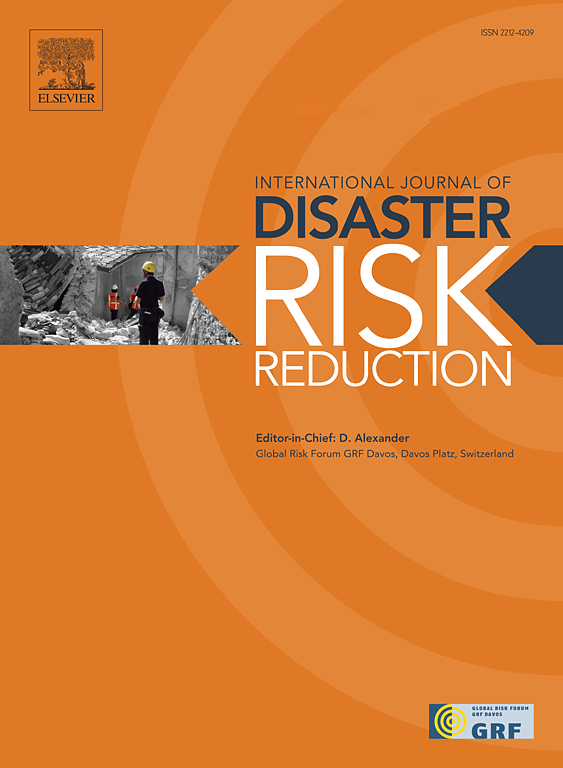A conceptual framework for implementing green-grey infrastructures to mitigate urban flood through source-to-hazard intervention pattern
IF 4.2
1区 地球科学
Q1 GEOSCIENCES, MULTIDISCIPLINARY
International journal of disaster risk reduction
Pub Date : 2025-04-15
DOI:10.1016/j.ijdrr.2025.105432
引用次数: 0
Abstract
The urgency of tackling flood disaster in coastal cities has grown due to the impact of climate change and rapid urbanization. Implementing a combination of green and grey infrastructures has emerged as a highly effective approach for mitigating urban flooding. Given the complex dynamics of urban runoff, it is crucial to evaluate various strategies involving these infrastructures to efficiently manage flood risk. To address these challenges, this study proposes a conceptual framework aimed at implementing green-grey infrastructure strategies, with a specific focus on mitigating flood volume from source area to hazard area. By employing a tracer-aided urban flood model, this framework can effectively decrease flood volume within drainage systems, thereby reducing potential losses from urban flooding. Furthermore, the cost-benefit of green-grey infrastructure in flood management was thoroughly assessed, providing a robust quantitative foundation for flood mitigation and cost management. The framework was successfully applied to the Longkungou drainage system in Haikou City. The results showed a reduction in flood volume by 339836 m3, with a reduction rate of 36.1%, which achieved the expected flood mitigation target. Cost-benefit analysis further revealed that relying solely on either grey or green infrastructure is inadequate for optimal stormwater management. While grey infrastructure demonstrates high efficiency in addressing major flood events, green infrastructure offers significant environmental benefits and is particularly effective for smaller rainfall events. The integration of both green and grey infrastructures has been proved to be the most beneficial overall for disaster mitigation. In summary, this study highlights the importance of combining green and grey infrastructure strategies to achieve comprehensive and effective urban flood management.
通过从源头到危害的干预模式实施绿灰基础设施以缓解城市洪水的概念框架
由于气候变化和快速城市化的影响,应对沿海城市洪水灾害的紧迫性日益增加。实施绿色和灰色基础设施的结合已经成为缓解城市洪水的一种非常有效的方法。考虑到城市径流的复杂动态,评估涉及这些基础设施的各种策略以有效管理洪水风险至关重要。为了应对这些挑战,本研究提出了一个概念性框架,旨在实施绿灰基础设施战略,特别侧重于减少从源头到危险区的洪水量。通过使用示踪剂辅助的城市洪水模型,该框架可以有效地减少排水系统内的洪水量,从而减少城市洪水的潜在损失。此外,对绿灰基础设施在洪水管理中的成本效益进行了全面评估,为洪水缓解和成本管理提供了坚实的定量基础。该框架已成功应用于海口市龙孔沟排水系统。结果表明,减少洪水量339836 m3,减少率36.1%,达到了预期的防洪目标。成本效益分析进一步表明,仅仅依靠灰色或绿色基础设施不足以实现最佳的雨水管理。灰色基础设施在应对重大洪水事件方面表现出高效率,而绿色基础设施则提供了显著的环境效益,对较小的降雨事件尤其有效。绿色和灰色基础设施的整合已被证明是最有利于减轻灾害的整体方式。总之,本研究强调了绿色和灰色基础设施战略相结合的重要性,以实现全面有效的城市洪水管理。
本文章由计算机程序翻译,如有差异,请以英文原文为准。
求助全文
约1分钟内获得全文
求助全文
来源期刊

International journal of disaster risk reduction
GEOSCIENCES, MULTIDISCIPLINARYMETEOROLOGY-METEOROLOGY & ATMOSPHERIC SCIENCES
CiteScore
8.70
自引率
18.00%
发文量
688
审稿时长
79 days
期刊介绍:
The International Journal of Disaster Risk Reduction (IJDRR) is the journal for researchers, policymakers and practitioners across diverse disciplines: earth sciences and their implications; environmental sciences; engineering; urban studies; geography; and the social sciences. IJDRR publishes fundamental and applied research, critical reviews, policy papers and case studies with a particular focus on multi-disciplinary research that aims to reduce the impact of natural, technological, social and intentional disasters. IJDRR stimulates exchange of ideas and knowledge transfer on disaster research, mitigation, adaptation, prevention and risk reduction at all geographical scales: local, national and international.
Key topics:-
-multifaceted disaster and cascading disasters
-the development of disaster risk reduction strategies and techniques
-discussion and development of effective warning and educational systems for risk management at all levels
-disasters associated with climate change
-vulnerability analysis and vulnerability trends
-emerging risks
-resilience against disasters.
The journal particularly encourages papers that approach risk from a multi-disciplinary perspective.
 求助内容:
求助内容: 应助结果提醒方式:
应助结果提醒方式:


